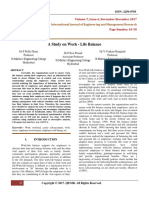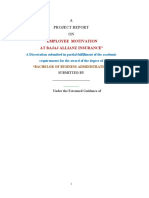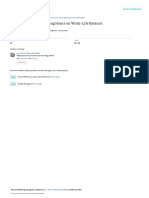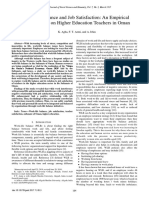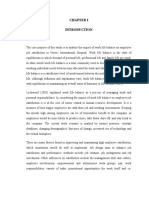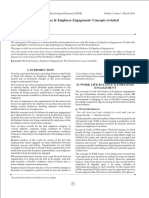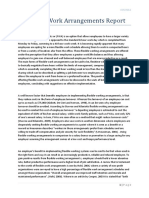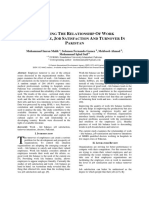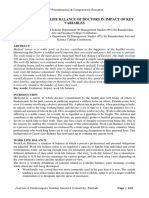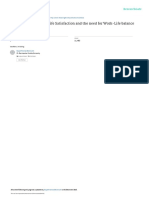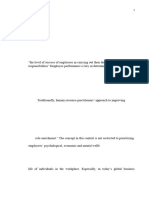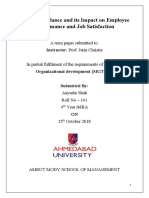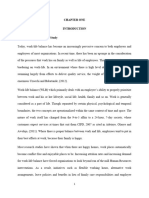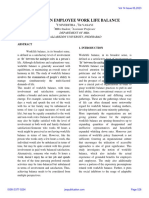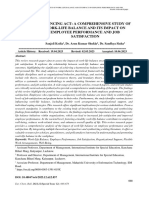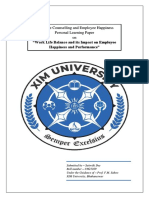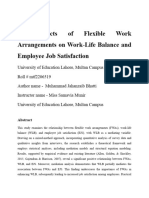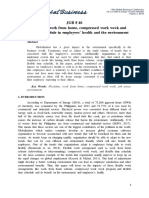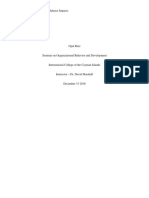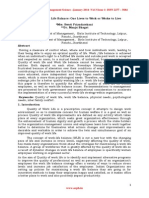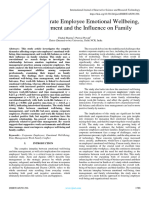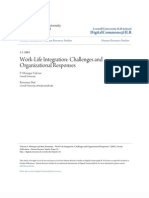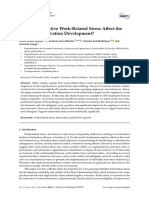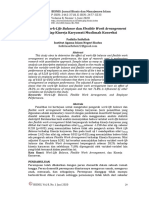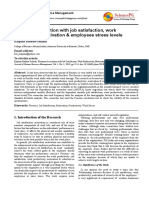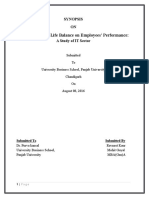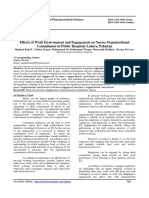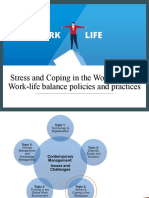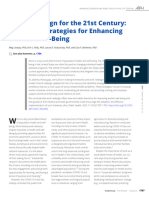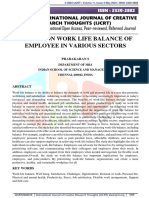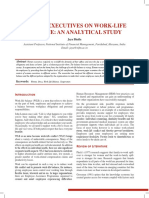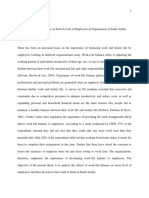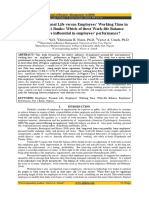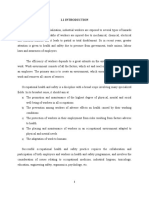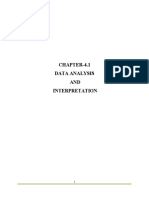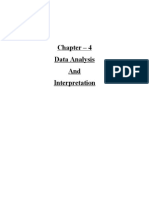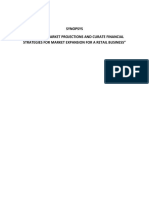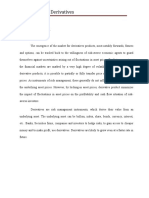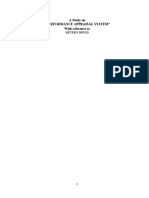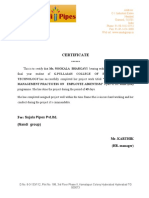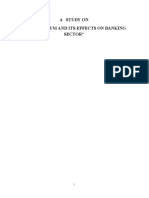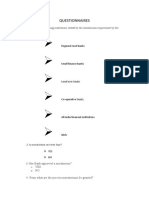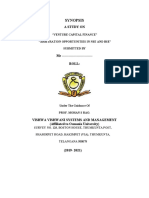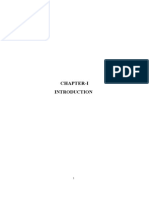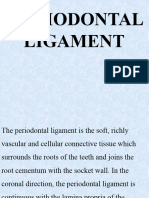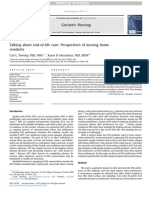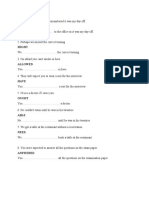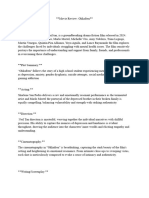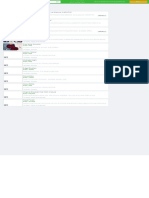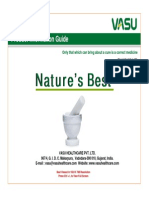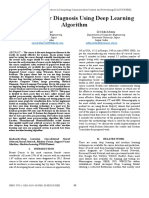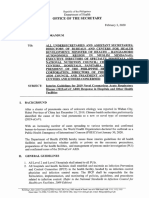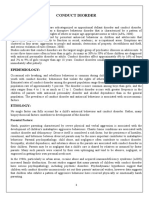Flexible
Flexible
Uploaded by
aurorashiva1Copyright:
Available Formats
Flexible
Flexible
Uploaded by
aurorashiva1Original Description:
Copyright
Available Formats
Share this document
Did you find this document useful?
Is this content inappropriate?
Copyright:
Available Formats
Flexible
Flexible
Uploaded by
aurorashiva1Copyright:
Available Formats
21
Impact of Flexible Working
Hours on employee
performance spectively. The literature lacks the evidence of flexible
working hours impacting on work-life balance; however,
ABSTRACT two concepts are frequently used together in the studies.
The paper proceeds with a brief discussion on a chosen
Nowadays, flexible working hours are becoming topic. And finally, conclusion is provided to summarize
important to the workplaces. A lot of organizations the ideas of the paper.
offer flexible working hours to employees due to the
benefits that flexibility gives to both employee and 2. Flexible Working Hours
employer. Greater employee productivity and
higher organization profitability are the most Work flexibility implies not only variation in time and
common benefits. Also, flexible work- ing hours place of the job, but also sharing of the job, career breaks
promote and facilitate work-life balance. Reduced (maternity/paternity leaves), part-time and term-time
stress and increased employee wellbeing are out- working [5]. In the other study on flexible work arrange-
comes of the work-life balance. In this paper, the ment (FWA), researchers discussed three broad catego-
relationship between flexible working hours and ries of FWA-flexi-time (flexibility in scheduling), tele-
work-life bal- ance is investigated. homeworking (flexibility in location), and part-time (fle-
xibility in length of the work) [6]. While each of the ar-
1. Introduction rangement could be used individually, they are frequen-
tly combined to compliment each other [7]. It should be
Flexible working hours have recently gained a lot of at- noted that work flexibility offers convenience in planning,
tention from organizations and scholars as family- not reducing the working time. Thus, flexibility in work
friendly policy. Nowadays, organizations are trying to might be summarized as the ability of employee to con-
incorporate a culture of trust by offering employees trol his/her working time duration as well as location of
flexibility in the workplace [1]. In addition, some work (remotely from office), this ability in scheduling
researchers argue that flexible working practices
facilitate work-life balance, and with shifting family
patterns such practices are be- neficial for both women
and men [2-4]. In this paper, relationship between
flexible working hours and work- life balance is
examined. This paper investigates whether flexible
working hours support and enhance work-life balance or
conversely create difficulties in balancing between work
and life roles.
Firstly, some previous findings on flexible working
hours are examined. With the use of existing evidence,
flexible working hours are considered from employee
and employer sides in order to show that flexibility in the
workplace beneficial is not only for employee, but for
employer as well. Secondly, existing literature on work-
life balance is scanned. Stress and employee wellbeing
are discussed as they are two key outcomes of work-life
balance, one is negative and the other one is positive re-
OPEN ACCESS AJIBM
American Journal of Industrial and Business Management, 2014, 4, 20-23
work suppose to be offered by employer [8]. an effect of conflict between work and life responsibili-
ties [19]. In their study on the support for the work-life
2.1. Benefits for Employers balance, researchers found that emotional and instrumen-
Employers have introduced flexible working packages tal support for employee during the work has a positive
(part of work-life policy) in order to attract, recruit, and relationship with the work-life balance satisfaction [20].
retain highly qualified staff to their organizations [9]. The positive relationship has been found between work-
With the ability to schedule the work himself/herself, life balance and work performance [21]. Thus, successful
employee feels that employer cares about wellbeing and accomplishment of life responsibilities (family and pa-
non-working life of employee [10]. That leads to in- rental roles) results in better work performance. While
creased satisfaction with the job and employer, resulting finding a balance in life and work responsibilities in-
in higher work commitment [11]. According to some crease general life satisfaction [22].
other previous findings, flexible working result in em-
ployee loyalty and engagement, increased organizational 3.1. Stress and Work-Life Balance
commitment, and higher job satisfaction, also flexible Each person defines stress in a different way. For some
working packages help to recruit and retain talented em- stress occurs from working overtime, from pressure to
ployees for the organization [12]. Furthermore, increased meet deadlines, or from fear of failure. In general, stress
productivity, reduced employee turnover and absentee- occurs when person has no control over when, where,
ism have been identified as advantages of flexible work- and how he/she does the work [23]. High level of stress
ing for the employers [13]. Thus, flexible working prac- might result in mental and physical health problems, such
tices are beneficial for employers, hence flexibility was as headaches, depression, heart attack, and cancer; stress
embedded to the work in order to give employees an op- is also an antecedent of unhappy and disharmonious rela-
tion to choose at what time, how much time, and from tionships that cause work-life conflict [24]. The evidence
which place to work. suggests that those employees who have work-life bal-
ance difficulties experience higher stress then those who
2.2. Benefits for Employees
found balance between work and life responsibilities
Despite apparent advantages of flexible working prac- [25].
tices (employee personal control over work scheduling),
some employees, mostly men, think that such practices 3.2. Wellbeing and Work-Life Balance
result in lower income and higher employment insecurity
The definition of wellbeing is associated with health and
[14]. According to the same findings, men see flexible
wellness [26]. It is employer’s responsibility to create
working practices as a way to develop their organiza-
working environment (workplace wellness culture) that
tional commitment, while women associate flexibility
promote employee wellbeing [27]. Furthermore, authors
with the work-life balance improvement. The evidence
suggest that physiological wellbeing leads to mental
suggests that flexible working practices fit women more
wellbeing, and both are helping to achieve work-life
then men and are more likely to be employed by women
balance. The other previous findings suggest that em-
due to the ideology beliefs of motherhood [15]. The
ployee wellbeing directly influence productivity and per-
findings from previous research also assert that women
formance; as well as organizational commitment, job
request and access the flexible working hours more fre-
satisfaction, and work-life balance are outcomes of em-
quently then men [16]. However, due to the changing
ployee wellbeing [28-30].
family patterns and gender norms, as well as rise of
women workforce, flexible employment is slowly started
utilizing by men these days [17]. Flexible working prac- 4. Flexible Working Hours and Work-Life
tices help to fulfil work-life responsibilities and might Balance
result in work-life balance. The literature suggests that Flexible working hours have been introduced as a benefit
there is a positive relationship between flexible working for parent/caring employees in order to help them fulfil-
practices and health issues-employees’ better mental ling work and life responsibilities and achieving work-
health and stress reduction [18]. life balance [31]. In the recent work-life balance survey,
researchers found that employees believe that flexible
3. Work-Life Balance working practices improve workplace morale, which
might positively influence work-life balance; in addition
Work-life balance concept recently gained attention due
employees believe that employer is able to help them
to its relevance and importance to all employees, despite
balance their work and life roles [32]. As an example,
of their relationship status, family size, and number of
flexible working hours is one of the best activities to in-
children. Some researchers believe that lack of balance is
crease employee wellbeing, as it helps employee to deal
OPEN ACCESS AJIBM
Impact of Flexible Working Hours on Work-Life Balance 23
with responsibilities outside the work [33]. the workplace gives employees time to perform outside
of the work roles and it helps balance employees’ work
5. Discussion and life.
Flexible working practices are beneficial for both em- Trust between employer and employee is an important
ployee and employer. Hence, in the first place flexibility issue when it comes to flexible working hours. If not
was introduced to the workplace in order to help em- monitored by manager, flexible working hours might
ployees with kids or employees who care after siblings to create some difficulties in the workplace. Further study
manage their time between work and life. As flexibility on flexible working hours need to be taken to understand
gives employee the ability to control when, where, and the drawbacks of such practices. Only after investigating
how much time do they work, flexibility definitely con- flexible working practices from both positive and nega-
tributes to improvement in allocation of work and life tive sides, organizations might consider applying flexi-
responsibilities. Thus, employee might end up fulfilling bility to the workplace.
his/her working as well as well non-working roles easily.
Finally, successful achievement of inside the work and REFERENCES
outside the work responsibilities leads to finding work-
life balance, which increase overall life satisfaction. To [1] Expert Group Meeting, “Work-Life Policy, Practice and
summarize, it might be said that use of flexible working Potential,” Presentation to the Management Committee
Office of the Focal Women in the United Nations, Office
practices positively influence on work-life balance and of the Focal Point for Women, United Nations, 2010.
overall life satisfaction of the employee.
[2] P. Thomson, “The Business Benefits of Flexible Work-
Looking from employer point of view, flexibility in ing,” Strategic HR Review, Vol. 7, No. 2, 2008, pp. 17-22.
the workplace also brought some important benefits. http://dx.doi.org/10.1108/14754390810853129
Higher satisfaction with the work and employer, better [3] E. Pruyne, M. Powell and J. Parsons, “Developing a
employee performance, greater organizational commit- Strategy for Employee Wellbeing: A Framework for
ment, and lower employee turnover and absenteeism are Planning and Action,” Ashridge Business School, Nuf-
all outcomes of flexible working practices that at the end field Health, 2012.
lead to increasing company’s productivity and profitabil- [4] D. Hofacker and S. Konig, “Flexibility and Work-Life
ity. Conflict in Times of Crisis: A Gender Perspective,” In-
The stress on the work impacts on employee’s per- ternational Journal of Sociology and Social Policy, Vol.
33, No. 9-10, 2013, pp. 613-635.
sonal outside the work life, which creates difficulties in
http://dx.doi.org/10.1108/IJSSP-04-2013-0042
finding work-life balance. Stress causes some serious
[5] D. Torrington, S. Taylor, L. Hall and C. Atkinson, “Hu-
mental and physical problems that negatively influence
man Resource Management,” Financial Times Prentice
on employee’s productivity and wellbeing. Thus, it might Hall, New Jersey, 2011.
be said that on the work stress decreases employee’s [6] D. Possenried and J. Plantenga, “Access to Flexible Work
work-life balance, while wellbeing contributes to higher Arrangements, Working-Time Fit and Job Satisfaction,”
level of work-life balance. It is the responsibility of em- Tjalling C. Koopmans Research Institute, Utrecht, 2011.
ployer to create the wellness workplace (stress-free and [7] H. Chung, “Flexibility for Whom? Working Time Flex-
trust-based environment) for employees in order to in- ibility Practices of European Companies,” Tilburg Uni-
crease their productivity. versity, Tilburg, 2009.
Previously, flexible working hours have been highly [8] C. Atkinson and L. Hall, “Flexible working and hapiness
requested and used by women due to their family roles. in the NHS,” Employee Relations, Vol. 33, No. 2, 2011,
However, flexible working hours are offered to men as pp. 88-105.
well. Nowadays, both women and men due to the new [9] R. Croucher and C. Kelliher, “The Right to Requiest
family patterns use flexible working practices, where Flexible Working in Britain: The Law and Organizational
Realities,” European Journal of Comparative Law and
both parents have equal family roles and dual family in- Industrial Relations, Vol. 21, No. 3, 2005, pp. 503-529.
come. Thus, it is important for both of them to success-
[10] W. J. Casper and C. M. Harris, “Work Life Benefits and
fully fulfil work and life responsibilities and achieve Organizational Attachment: Self-Interest Utility and Sig-
work-life balance. naling Theory Models,” Journal of Vacational Behavior,
Vol. 72, No. 1, 2008, pp. 95-109.
6. Conclusions http://dx.doi.org/10.1016/j.jvb.2007.10.015
[11] C. Kelliher and D. Anderson, “Doing More with Less?
This paper examined flexible working hours from its
Flexible Working Practices and Intesification of Work,”
positive point of view. The investigation showed that in- Human Relations, Vol. 63, No. 1, 2010, pp. 83-106.
troduction of flexible working hours brought some bene- http://dx.doi.org/10.1177/0018726709349199
fits for both employee and employer. Also, flexibility in [12] D. Anderson and C. Kelliher, “Flexible Working and
OPEN ACCESS AJIBM
View publication stats
22 Impact of Flexible Working Hours on Work-Life Balance
Engagement: The Importance of Choice,” Strategic HR
[22] M. Pina e Cunha and A. Rego, “Do the Opportunities fo
Review, Vol. 8, No. 2, 2009, pp. 13-18.
Learning and Personal Development Lead to Happiness?
http://dx.doi.org/10.1108/14754390910937530
It depends on Work-Family Conciliation,” Journal of
[13] Anon, “Flexible Working as Human Resource Strategy: Occupational Health Psychology, Vol. 14, No. 3, 2009,
Benefits to the Organization and its Personnel,” Strategic pp. 334-348. http://dx.doi.org/10.1037/a0014248
Direction, Vol. 24, No. 8, 2008, pp. 9-11.
[23] K. Lockett, “Work/Life Balance for Dummies,” John
http://dx.doi.org/10.1108/02580540810884584
Wiley & Sons, Hoboken, 2012.
[14] D. Hofacker and S. Konig, “Flexibility and Work-Life
[24] T. Looker, “Manage Your Stress for a Happier Life,”
Conflict in Times of Crisis: A Gender Perspective,”
Copyright Licensing Agency Limited, London, 2011.
In- ternational Journal of Sociology and Social Policy,
Vol. 33, No. 9-10, 2013, pp. 613-635. [25] G. Lowe, “Under Pressure: Implication of Work-Life
http://dx.doi.org/10.1108/IJSSP-04-2013-0042 Balance and Job Stress,” Wilson Banwell PROACT Hu-
man Solutions, Kingston, 2006.
[15] S. Lewis and A. L. Humbert, “Work-Life Balance, Flexi-
ble Working Policies and the Gendered Organization,” [26] E. Pruyne, M. Powell and J. Parsons, “Developing a
Equality, Diversity and Inclusion: An International Jour- Strategy for Employee Wellbeing: A Framework for
nal, Vol. 29, No. 3, 2010, pp. 239-254. Planning and Action,” Ashridge Business School, Nuf-
http://dx.doi.org/10.1108/02610151011028840 field Health, 2012.
[16] N. Skinner and B. Pocock, “Flexibility and Work-lIfe [27] E. E. Kossek, T. Kalliath and P. Kalliath, “Achieving
Interference,” Journal of Industrial Relations, Vol. 53, Employee Wellbeing in a Changing Work Environment,”
No. 1, 2011, pp. 65-82. International Journal of Manpower, Vol. 33, No. 7, 2012,
http://dx.doi.org/10.1177/0022185610390297 pp. 738-753.
http://dx.doi.org/10.1108/01437721211268294
[17] D. Hofacker and S. Konig, “Flexibility and Work-Life
Conflict in Times of Crisis: A Gender Perspective,” [28] R. N. Baptiste, “Tightening the Link between Employee
In- ternational Journal of Sociology and Social Policy, Wellbeing at Work and Performance,” Management De-
Vol. 33, No. 9-10, 2013, pp. 613-635. sicion, Vol. 46, No. 2, 2008, pp. 284-308.
http://dx.doi.org/10.1108/IJSSP-04-2013-0042 [29] K. A. Jain, I. S. Giga and L. C. Cooper, “Employee
[18] M. Shapiro, C. Ingols, R. O’Neill and S. Blake-Beard, Wellbeing, Control and Organizational Commitment,”
“Making Sense of Women as Career Self-Agents: Impli- Leadership & Organization Development Journal, Vol.
cations for Human Resource Development,” Human Re- 30, No. 3, 2009, pp. 256-273.
source Development Quarterly, Vol. 20, No. 4, 2009, pp. http://dx.doi.org/10.1108/01437730910949535
477-501. http://dx.doi.org/10.1002/hrdq.20030 [30] E. E. Kossek, T. Kalliath and P. Kalliath, “Achieving
[19] H. Lingard and V. Francis, “Managing Work-Life Bal- Employee Wellbeing in a Changing Work Environment,”
ance in Construction,” Spon Press, New York, 2009. International Journal of Manpower, Vol. 33, No. 7, 2012,
pp. 738-753.
[20] A.-K. Abendroth and L. den Dulk, “Support for the
http://dx.doi.org/10.1108/01437721211268294
Work-Life Balance in Europe: The Impact of State,
Workplace, and Family Support on Work-Life Balance [31] P. Thomson, “The Business Benefits of Flexible Work-
Satisfaction,” Work, Employment, and Society, Vol. 25, ing,” Strategic HR Review, Vol. 7, No. 2, 2008, pp. 17-22.
No. 2, 2011, pp. 234-256. http://dx.doi.org/10.1108/14754390810853129
http://dx.doi.org/10.1177/0950017011398892 [32] S. Tipping, J. Chanfreau, J. Perry and C. Tait, “The
[21] S. K. Lyness and K. M. Judiesch, “Can a Manager have a Fourth Work-Life Balance Employee Survey,”
Life and a Career? International and Multisource Perspec- Department for Business, Innovation and Skills (BIS),
tive on Work-Life Balance and Career Advancement Po- London, 2012.
tential,” Journal of Applied Psychology, Vol. 93, No. 4, [33] E. Pruyne, M. Powell and J. Parsons, “Developing a
2008, pp. 789-805. Strategy for Employee Wellbeing: A Framework for
http://dx.doi.org/10.1037/0021-9010.93.4.789 Planning and Action,” Ashridge Business School, Nuf-
field Health, 2012.
OPEN ACCESS AJIBM
You might also like
- Ambulance Service SopDocument27 pagesAmbulance Service SopKlinik Radiologi73% (11)
- A Study On Work Life BalanceDocument8 pagesA Study On Work Life BalancePutu Ika PratiwiNo ratings yet
- "Employee Motivation at Bajaj Allianz Insurance": A Project Report ONDocument71 pages"Employee Motivation at Bajaj Allianz Insurance": A Project Report ONaurorashiva1100% (2)
- Internet Marketing Full Project ReportDocument77 pagesInternet Marketing Full Project Reportaurorashiva1No ratings yet
- Impact of Flexible Working Hours On Work-Life Balance: Sussanna Shagvaliyeva, Rashad YazdanifardDocument4 pagesImpact of Flexible Working Hours On Work-Life Balance: Sussanna Shagvaliyeva, Rashad YazdanifardNurul IzzatyNo ratings yet
- Impact of Flexible Working Hours On Work-Life Balance: Sussanna Shagvaliyeva, Rashad YazdanifardDocument4 pagesImpact of Flexible Working Hours On Work-Life Balance: Sussanna Shagvaliyeva, Rashad YazdanifardNurul IzzatyNo ratings yet
- Impact of Flexible Working Hours On Work-Life BalanceDocument5 pagesImpact of Flexible Working Hours On Work-Life BalanceAsyrofNo ratings yet
- Work Life Balance 2Document8 pagesWork Life Balance 2nadipallsrirajNo ratings yet
- Gigi Some Research ReferenceDocument7 pagesGigi Some Research ReferenceMaricris SalinasNo ratings yet
- 1.1. BackgroundDocument10 pages1.1. BackgroundBeebek ChaudharyNo ratings yet
- San Thida Swe, 2018A5840, Research ProjectDocument21 pagesSan Thida Swe, 2018A5840, Research ProjectSan Thida SweNo ratings yet
- Format. Hum - A Study On Work Life Balance With Special ReferenceDocument8 pagesFormat. Hum - A Study On Work Life Balance With Special ReferenceImpact JournalsNo ratings yet
- Format. Hum - A Study On Work Life Balance With Special ReferenceDocument8 pagesFormat. Hum - A Study On Work Life Balance With Special ReferenceImpact JournalsNo ratings yet
- Effect of Work-Life Balance On Employee Engagement in Increasing Employee PerformanceDocument7 pagesEffect of Work-Life Balance On Employee Engagement in Increasing Employee PerformanceAJHSSR Journal100% (1)
- Ij 8Document3 pagesIj 8anushanNo ratings yet
- Flexible Work Arrangements ReportDocument6 pagesFlexible Work Arrangements ReportZac Manson100% (1)
- 4 Jicr October SP 2020Document8 pages4 Jicr October SP 2020RamandeepNo ratings yet
- 02 01 03 1 PDFDocument7 pages02 01 03 1 PDFBelinda MeganNo ratings yet
- Jurnal EkonomiDocument9 pagesJurnal EkonomiKacang HijauNo ratings yet
- Impact of Flexible Working Arrangements On Employee Satisfaction in It SectorDocument15 pagesImpact of Flexible Working Arrangements On Employee Satisfaction in It SectorFarid KaskarNo ratings yet
- A Study of Worklife Balance of DoctorsDocument6 pagesA Study of Worklife Balance of DoctorsDr D DivyaNo ratings yet
- PRSU2016Document14 pagesPRSU2016DhruboNo ratings yet
- Main Content TVS Impact of WLB - 240818 - 002530Document75 pagesMain Content TVS Impact of WLB - 240818 - 002530suki05112000No ratings yet
- Flexible Work ArrangementDocument22 pagesFlexible Work ArrangementredmondolasunkanmiNo ratings yet
- UH21109Document12 pagesUH21109Sattwiki DeyNo ratings yet
- Od Term PaperDocument20 pagesOd Term PaperAayushi ShahNo ratings yet
- Chapter OneDocument9 pagesChapter OneSeun OgunlaNo ratings yet
- 2023 V14i5069Document9 pages2023 V14i5069samusichubNo ratings yet
- Smith WLBDocument27 pagesSmith WLBSteffi SunurNo ratings yet
- Balancing Act: A Comprehensive Study of Work-Life Balance and Its Impact On Employee Performance and Job SatisfactionDocument11 pagesBalancing Act: A Comprehensive Study of Work-Life Balance and Its Impact On Employee Performance and Job Satisfactionmohitjuyal50645No ratings yet
- 5 PDFDocument19 pages5 PDFChEen TIdoreNo ratings yet
- ITPRDocument22 pagesITPRjaisa2193No ratings yet
- UH21109Document12 pagesUH21109Sattwiki DeyNo ratings yet
- Jahanzaib Research-5Document25 pagesJahanzaib Research-5Nauman AkramNo ratings yet
- JGB # 46Document7 pagesJGB # 46Ayna EngraciaNo ratings yet
- Relationship Between Work-Life Balance and Organizational Excellence: A Conceptual ModelDocument8 pagesRelationship Between Work-Life Balance and Organizational Excellence: A Conceptual Modelimrul khanNo ratings yet
- A Study On Work Life Balance Among BPO EmployeesDocument15 pagesA Study On Work Life Balance Among BPO EmployeesCharmi PoraniyaNo ratings yet
- Organizational Behavior and Development - Work Life Balance Paper - FinalDocument27 pagesOrganizational Behavior and Development - Work Life Balance Paper - Finalapi-342063173No ratings yet
- Quality of Work Life Balance One Lives To Work or Works To Live-LibreDocument7 pagesQuality of Work Life Balance One Lives To Work or Works To Live-LibreWidyaUtamiNo ratings yet
- Chapter I IntroductionDocument10 pagesChapter I IntroductionKarthikeyan ThangarajuNo ratings yet
- Nurturing Corporate Employee Emotional Wellbeing, Time Management and The Influence On FamilyDocument8 pagesNurturing Corporate Employee Emotional Wellbeing, Time Management and The Influence On FamilyInternational Journal of Innovative Science and Research TechnologyNo ratings yet
- Work-Life Integration: Challenges and Organizational ResponsesDocument23 pagesWork-Life Integration: Challenges and Organizational ResponsesMaria M. Romero TNo ratings yet
- Strategic Work-Life Balance - Enhancing Productivity and RetentionDocument9 pagesStrategic Work-Life Balance - Enhancing Productivity and RetentionWeb ResearchNo ratings yet
- Work-Life Balance: Contrasting Managers and Workers in An MNCDocument15 pagesWork-Life Balance: Contrasting Managers and Workers in An MNCLakshya VermaNo ratings yet
- How Does Positive Work-Related Stress A Degree of Innovation Development?Document15 pagesHow Does Positive Work-Related Stress A Degree of Innovation Development?mariaNo ratings yet
- 6762 25767 1 PBDocument8 pages6762 25767 1 PBSri Amalia EdyNo ratings yet
- 10 11648 J JHRM 20130101 12 PDFDocument6 pages10 11648 J JHRM 20130101 12 PDFmayesha yousufNo ratings yet
- A Study On Work Life Balance Among BPO Employees - With Reference To BPO'S inDocument9 pagesA Study On Work Life Balance Among BPO Employees - With Reference To BPO'S inomkarNo ratings yet
- Synopsis Mohit RavneetDocument17 pagesSynopsis Mohit RavneetRavNeet KaUrNo ratings yet
- Effects of Work Environment and Engagement On Nurses Organizational Commitment in Public Hospitals Lahore, PakistanDocument6 pagesEffects of Work Environment and Engagement On Nurses Organizational Commitment in Public Hospitals Lahore, PakistanErni Yessyca SimamoraNo ratings yet
- Work Life Balance Practices and Employees Productivity in The Nigerian University SystemDocument13 pagesWork Life Balance Practices and Employees Productivity in The Nigerian University Systemimrul khanNo ratings yet
- Stress and Coping in The Workplace II: Work-Life Balance Policies and PracticesDocument27 pagesStress and Coping in The Workplace II: Work-Life Balance Policies and PracticesVu MinhNo ratings yet
- Amity JournalDocument11 pagesAmity JournalvidhiNo ratings yet
- 343 1023 1 PBDocument25 pages343 1023 1 PBlionaramadani febriosaNo ratings yet
- Project DuroflexDocument89 pagesProject DuroflexElizabeth ThomasNo ratings yet
- WLBDocument15 pagesWLBpramod100% (1)
- Work Redesign and Well Being24Document9 pagesWork Redesign and Well Being24KKGNo ratings yet
- IJCRT23A5018Document7 pagesIJCRT23A5018mohitjuyal50645No ratings yet
- Women Executives On Work-Life Balance: An Analytical StudyDocument8 pagesWomen Executives On Work-Life Balance: An Analytical StudyAbdullah SiddiqNo ratings yet
- Eceh PLPDocument11 pagesEceh PLPSattwiki DeyNo ratings yet
- Sample 2Document14 pagesSample 2David KariukiNo ratings yet
- Employees' Personal Life Versus Employees' Working Time in Nigeria's Tier 1 Banks: Which of These Work-Life Balance Issues Is More Influential in Employees' Performance?Document7 pagesEmployees' Personal Life Versus Employees' Working Time in Nigeria's Tier 1 Banks: Which of These Work-Life Balance Issues Is More Influential in Employees' Performance?aijbmNo ratings yet
- A Study On Employee StressDocument19 pagesA Study On Employee Stressaurorashiva1No ratings yet
- Project Health and Safety Measures of EmployeeDocument83 pagesProject Health and Safety Measures of Employeeaurorashiva1No ratings yet
- A Study On Cash Flow @@@tata Type 2Document69 pagesA Study On Cash Flow @@@tata Type 2aurorashiva1No ratings yet
- CAFFFDocument71 pagesCAFFFaurorashiva1No ratings yet
- The Impact of Flexible Working Hours and Psychological Empowerment On Team Performance With The Mediating Role of Work EngagementDocument15 pagesThe Impact of Flexible Working Hours and Psychological Empowerment On Team Performance With The Mediating Role of Work Engagementaurorashiva1No ratings yet
- Plagiarism Checker X - Report: Originality AssessmentDocument30 pagesPlagiarism Checker X - Report: Originality Assessmentaurorashiva1No ratings yet
- Chapter 4Document17 pagesChapter 4aurorashiva1No ratings yet
- Chapter-4 and 5 of Emp SatisfDocument28 pagesChapter-4 and 5 of Emp Satisfaurorashiva1No ratings yet
- Financial Statement Analysis of HeteroDocument103 pagesFinancial Statement Analysis of Heteroaurorashiva1No ratings yet
- Synopsis AtharudiinDocument39 pagesSynopsis Atharudiinaurorashiva1No ratings yet
- Financial Derivatives33Document65 pagesFinancial Derivatives33aurorashiva1No ratings yet
- Stressdsss MGMTDocument86 pagesStressdsss MGMTaurorashiva1No ratings yet
- A Study On PERFORMANCE - HETERODocument67 pagesA Study On PERFORMANCE - HETEROaurorashiva1No ratings yet
- Certificate: Sujala Pipes PVT - Ltd. (Nandi Group)Document1 pageCertificate: Sujala Pipes PVT - Ltd. (Nandi Group)aurorashiva1No ratings yet
- Dealer S Perception About SUJALA PVC PipesDocument68 pagesDealer S Perception About SUJALA PVC Pipesaurorashiva1No ratings yet
- Management of Surplus PR5Document52 pagesManagement of Surplus PR5aurorashiva1No ratings yet
- A STUDY ON ReviewDocument28 pagesA STUDY ON Reviewaurorashiva1No ratings yet
- Capital Market-Md SameerDocument50 pagesCapital Market-Md Sameeraurorashiva1No ratings yet
- Role of Institutional and Small Investors in Capital Markets in IndiaDocument75 pagesRole of Institutional and Small Investors in Capital Markets in Indiaaurorashiva1No ratings yet
- Lokesh J SynDocument10 pagesLokesh J Synaurorashiva1No ratings yet
- Questionnaires: 1. Which Are The Lending Institutions Covered by The Moratorium Requirement by The Customers?Document4 pagesQuestionnaires: 1. Which Are The Lending Institutions Covered by The Moratorium Requirement by The Customers?aurorashiva1No ratings yet
- Management of Surplus PR5Document82 pagesManagement of Surplus PR5aurorashiva1No ratings yet
- Final Doc Sure Nder Bank AuditDocument62 pagesFinal Doc Sure Nder Bank Auditaurorashiva1No ratings yet
- Synopsis: A Study OnDocument60 pagesSynopsis: A Study Onaurorashiva1No ratings yet
- A Study On IlopDocument55 pagesA Study On Ilopaurorashiva1No ratings yet
- Product Lifecycle - 1Document43 pagesProduct Lifecycle - 1aurorashiva1No ratings yet
- Ge 35 PSX: Use and Maintenance ManualDocument54 pagesGe 35 PSX: Use and Maintenance ManualTomaBogdanovNo ratings yet
- Health PresentationDocument16 pagesHealth PresentationSCS-Abarquez, Christel Jade D.No ratings yet
- Van Riet, C., & Demeulemeester, E. (2014) - Trade-Offs in Operating Room Planning For Electives and Emergencies A Review. Available at SSRN 2553849.Document18 pagesVan Riet, C., & Demeulemeester, E. (2014) - Trade-Offs in Operating Room Planning For Electives and Emergencies A Review. Available at SSRN 2553849.shirin_999788516No ratings yet
- - periodontal Ligament Ppt - نسخةDocument43 pages- periodontal Ligament Ppt - نسخةkoka51339No ratings yet
- OHSU COVID Forecast: Edition: 12/17/2021Document46 pagesOHSU COVID Forecast: Edition: 12/17/2021Sinclair Broadcast Group - EugeneNo ratings yet
- Role of Community Health Nurse As A Change Agent: ArticleDocument6 pagesRole of Community Health Nurse As A Change Agent: ArticleJasneil AcenasNo ratings yet
- Ibps-Po 22 T2 01 QDocument60 pagesIbps-Po 22 T2 01 Qadil936919No ratings yet
- Geriatric Nursing: Gail L. Towsley, PHD, Nha, Karen B. Hirschman, PHD, MSWDocument5 pagesGeriatric Nursing: Gail L. Towsley, PHD, Nha, Karen B. Hirschman, PHD, MSWEva RiantikaNo ratings yet
- Reading Exam Practice 2Document3 pagesReading Exam Practice 2fabrydjNo ratings yet
- Database Management SystemDocument4 pagesDatabase Management SystemOwen LuzNo ratings yet
- Self Management SkillsDocument29 pagesSelf Management SkillsRajesh RanjanNo ratings yet
- Movie ReviewDocument2 pagesMovie Reviewgabriellevelasco23No ratings yet
- Study of Evolution and Nutritional Impact in DiabetesDocument9 pagesStudy of Evolution and Nutritional Impact in DiabetesDana SNo ratings yet
- Embrace SP Version Bi TC 201612 FinalDocument9 pagesEmbrace SP Version Bi TC 201612 Finalka yat ngaiNo ratings yet
- K.V.P. Sanstha's KVTR Ayurved College, BoradiDocument4 pagesK.V.P. Sanstha's KVTR Ayurved College, Boradimahendrajadhav007mumbaiNo ratings yet
- 14.20022018 Paul Bussey-RIBA CDM PD Documentation - Universities Short Couse (171107) v1Document68 pages14.20022018 Paul Bussey-RIBA CDM PD Documentation - Universities Short Couse (171107) v1Florina Mihaila100% (1)
- Ese Ushaka Kwivuza Hypertension-ManualDocument990 pagesEse Ushaka Kwivuza Hypertension-ManualPhillip MillerNo ratings yet
- Vasu Product Information GuideDocument55 pagesVasu Product Information GuideSamhitha Ayurvedic Chennai100% (2)
- Chapter 3Document17 pagesChapter 3Yousif JawadNo ratings yet
- Tumor Marker 12345678Document65 pagesTumor Marker 12345678Anonymous VYOTJhGNo ratings yet
- Breast Cancer Diagnosis Using Deep Learning Algorithm: Naresh Khuriwal DR Nidhi MishraDocument6 pagesBreast Cancer Diagnosis Using Deep Learning Algorithm: Naresh Khuriwal DR Nidhi MishraNeha SwanthalNo ratings yet
- DOH-Interim-Guidelines Covid-19 Hospitals-and-other-Health-FacilitiesDocument30 pagesDOH-Interim-Guidelines Covid-19 Hospitals-and-other-Health-FacilitiesLet TemplonuevoNo ratings yet
- The Sports Medicine Physician: EditorsDocument673 pagesThe Sports Medicine Physician: EditorsRenan Sequini FavaroNo ratings yet
- Conduct DisordersDocument17 pagesConduct DisordersMamta PooniaNo ratings yet
- Be LCP Assessment and Be Plans Buenlag Central School 101429 202 2021Document18 pagesBe LCP Assessment and Be Plans Buenlag Central School 101429 202 2021lymieng Star limoicoNo ratings yet
- Toolbox Talk - Slips Trips & Falls - ENDocument1 pageToolbox Talk - Slips Trips & Falls - ENJomy JohnyNo ratings yet
- Excretory System & DigestiveDocument15 pagesExcretory System & Digestivejmunozbio@yahoo.com100% (2)
- BCG The Future of Digital Health 2024 Jan 2024 1Document24 pagesBCG The Future of Digital Health 2024 Jan 2024 1Anindo ChakrabortyNo ratings yet
- Resume: Email Id: Profession: HSE Safety Engineer. Mobile No: Nellore, A.P IndiaDocument3 pagesResume: Email Id: Profession: HSE Safety Engineer. Mobile No: Nellore, A.P IndiaVivek VjNo ratings yet

